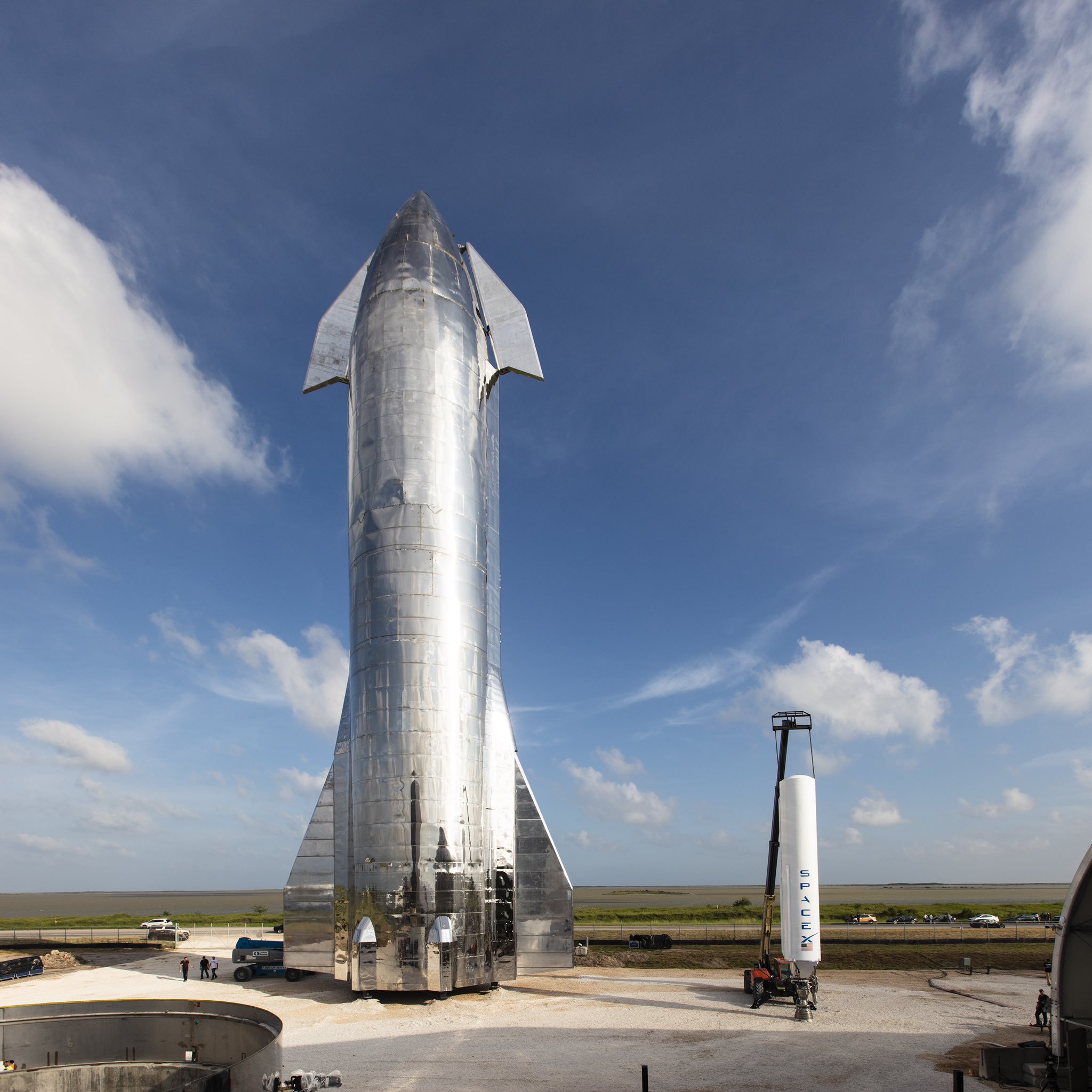SpaceX will soon have a whole fleet of shiny silver Starship prototypes, if all goes according to plan.
On Saturday (Sept. 28), Elon Musk gave his annual update about Starship and Super Heavy, the reusable spacecraft and rocket, respectively, that the company is building to help colonize Mars.
The presentation took place at SpaceX's South Texas site, near the village of Boca Chica, and prominently featured the 165-foot-tall (50 meters) Starship Mk1 — the first full-size Starship prototype, whose assembly was completed just days before Musk's talk. (One test-flight prototype preceded the Mk1 — a short and stubby vehicle called Starhopper, which was retired in late August.)
Video: How SpaceX's Starship Will Launch Into Orbit
Related: SpaceX's Starship and Super Heavy Rocket in Pictures

Launching Starships
SpaceX aims to launch the stainless-steel Mk1 on an uncrewed, 12-mile-high (20 kilometers) test flight in the next month or two, Musk said. And a much more ambitious jaunt should follow in relatively short order.
"I mean, this is going to sound totally nuts, but I think we want to try to reach orbit in less than six months," Musk said on Saturday.
But the Mk1 won't make that milestone flight. That distinction will likely go to the Mk4 or Mk5 Starship iteration, the billionaire entrepreneur added.
Get the Space.com Newsletter
Breaking space news, the latest updates on rocket launches, skywatching events and more!
Starship Mk2 is already under construction at SpaceX's Cape Canaveral facility, on Florida's Space Coast, and should be finished within the next couple of months at most, Musk said. (Competition between the teams at Boca Chica and the Cape should end up improving the final Starship design, the SpaceX founder and CEO has said.)
SpaceX plans to begin building the Mk3 at Boca Chica in about a month, and that prototype will likely be ready to fly about three months from now, Musk said. The Mk4 will take shape in Florida shortly thereafter — and it could end up being the first Starship vehicle to circle Earth.
Related: The Evolution of SpaceX Rockets in Pictures
Ambitious timeline
Like most of Musk's plans, these construction timelines are quite ambitious. (Musk has called his timelines "aspirational" in the past.)
SpaceX spent a lot of time on the Mk1, after all; construction work on that vehicle goes all the way back to at least December 2018. But the company has learned a lot in the intervening time, so getting a Starship to orbit by the spring of 2020 should be achievable, Musk said.
"Provided the rate of design improvement and manufacturing improvement continues to be exponential, I think that is accurate to within a few months," Musk said of the orbital launch timeline. (He did stress, however, that these target dates have not been rigorously vetted: "I'm giving you just literally stream of consciousness here.")
The Mk1 and Mk2 Starships sport three of SpaceX's next-generation Raptor engines. Versions starting with the Mk3, however, will be powered by six Raptors, just like the final, operational Starship, which Musk has said will be capable of carrying up to 100 passengers. (SpaceX's currently operational Falcon 9 and Falcon Heavy rockets use a different engine called the Merlin.)
SpaceX will probably need about 100 Raptors from here on out to get to orbit, counting the engines required for development and testing work, Musk said. But the tally will skyrocket when SpaceX starts building the Super Heavy, which won't happen until Starship Mk4 is done.
The Super Heavy has room for 37 Raptors, and at least 31 of those slots will likely be filled on each launch of the giant rocket, Musk said. (The first stage of SpaceX's biggest operational rocket, the Falcon Heavy, uses 27 Merlin engines: nine each on three attached boosters.)
"Add that up, you've got a lot of engines," he said. "So, spooling up the Raptor production rate is extremely important. Vital, obviously — essential to completing the booster."
SpaceX is currently building one Raptor every eight to 10 days but should pick up the pace markedly in the coming months, Musk added. The goal is to get to one Raptor per day by early 2020 at the latest.
If the manufacturing and testing work all goes well, and SpaceX does indeed get a Starship prototype to orbit in six months or so, an even bigger milestone could follow in relatively short order.
"I think we could potentially see people flying next year," Musk said.
- Elon Musk: Revolutionary Private Space Entrepreneur
- SpaceX Dragon Crew Demo-1 Test Flight: Full Coverage
- See the Evolution of SpaceX's Rockets in Pictures
Mike Wall's book about the search for alien life, "Out There" (Grand Central Publishing, 2018; illustrated by Karl Tate), is out now. Follow him on Twitter @michaeldwall. Follow us on Twitter @Spacedotcom or Facebook.

Join our Space Forums to keep talking space on the latest missions, night sky and more! And if you have a news tip, correction or comment, let us know at: community@space.com.

Michael Wall is a Senior Space Writer with Space.com and joined the team in 2010. He primarily covers exoplanets, spaceflight and military space, but has been known to dabble in the space art beat. His book about the search for alien life, "Out There," was published on Nov. 13, 2018. Before becoming a science writer, Michael worked as a herpetologist and wildlife biologist. He has a Ph.D. in evolutionary biology from the University of Sydney, Australia, a bachelor's degree from the University of Arizona, and a graduate certificate in science writing from the University of California, Santa Cruz. To find out what his latest project is, you can follow Michael on Twitter.









